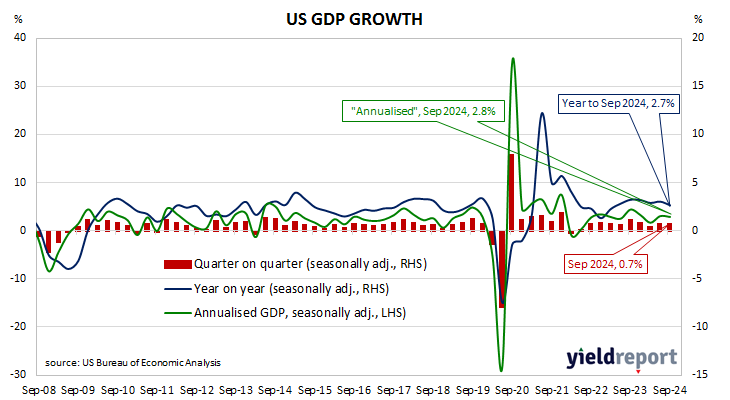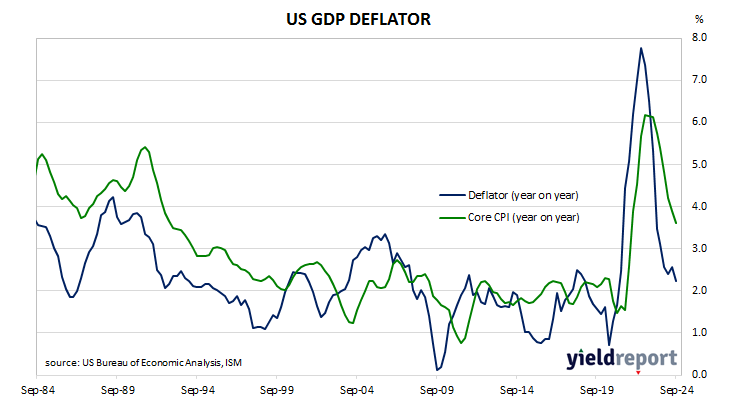Summary: US GDP up 0.7% (2.8% annualised) in September quarter, in line with expectations; up 2.7% over year; Westpac: stronger goods spending, services spending back to trend; US Treasury yields rise; rate-cut expectations soften; GDP price deflator rate slows from 2.6% to 2.2%.
US GDP growth slowed in the second quarter of 2019 before stabilising at about 0.5% per quarter. At the same time, US bond yields suggested future growth rates would be below trend. The US Fed agreed and it reduced its federal funds range three times in the second half of 2019. Pandemic restrictions in the June quarter of 2020 sent parts of the US economy into hibernation; the lifting of those same restrictions sparked a rapid recovery which lasted until 2022.
The US Bureau of Economic Analysis has now released the September quarter’s advance GDP estimate and it indicates the US economy expanded by 0.7% or at an annualised rate of 2.8%. The result was largely in line with the 0.7% increase (3.0% annualised) which had been generally expected as well as the June quarter’s 0.7% rise. On a year-on-year basis, GDP expanded by 2.7%, down from 3.0% after revisions to the previous quarter.
“GDP was broadly in line with our and the market’s expectation at 2.8% annualised in the September quarter,” said Westpac economist Jameson Coombs. “However, the consumer was stronger, total consumption growing 3.7% annualised as goods consumption spiked while momentum in services edged lower to an around-trend pace.”
US GDP numbers are published in a manner which is different to most other countries; quarterly figures are compounded to give an annualised figure. In countries such as Australia and the UK, an annual figure is calculated by taking the latest number and comparing it with the figure from the same period in the previous year. The diagram above shows US GDP once it has been expressed in the normal manner, as well as the annualised figure.
US Treasury bond yields rose by declining amounts out along the curve. By the close of business, the 2-year Treasury bond yields had gained 9bps to 4.19%, the 10-year yield had added 4bps to 4.30% while the 30-year yield finished unchanged at 4.50%.
In terms of US Fed policy, expectations of a lower federal funds rate in the next 12 months softened, although at least another four 25bp cuts are still factored in. At the close of business, contracts implied the effective federal funds rate would average 4.65% in November, 4.51% in December and 4.255% in February. September 2025 contracts implied 3.75%, 108bps less than the current rate.
One part of the report which is often overlooked are the figures regarding the GDP price deflator, which is another measure of inflation. The GDP price deflator is restricted to new, domestically-produced goods and services and it is not based on a fixed basket as is the case for the consumer price index (CPI). These latest figures indicate the annual rate slowed from 2.6% in the June quarter to 2.2%.



